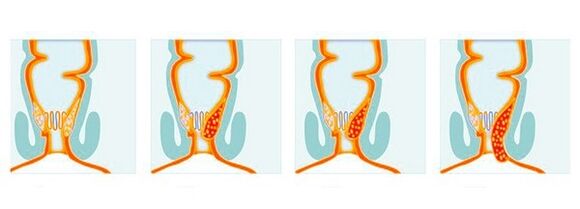
Hemorrhoids are a disease in which there are rectal complaints and abnormal changes in the blood in the veins of the rectum or in the area around the anus. Such a delicate pathology has no limits in terms of age and gender.
The underlying factor leading to the formation of hemorrhoid cones is stagnation, which in turn stems from a number of other predisposing factors.
Pathology is characterized by characteristic symptoms that one cannot ignore. The most specific clinical symptoms of hemorrhoids are itching and burning in the anal area, rectal bleeding, and severe pain in the perianal region.
A clinical physical examination will be able to establish the correct diagnosis, but in addition, some laboratory and instrumental tests may be required.
Treatment of hemorrhoids depends directly on the severity of the course of the disease and can therefore be both conservative and surgical.
Because there are quite a few types of pathology, it is coded with several meanings in the International Classification of Diseases.
Etiology
The main reason for the appearance of bleeding suppositories is:
- violation of the function of the blood vessels of this organ;
- increased arterial blood flow;
- abnormal blood outflow from the venous plexus;
- loss of tone in the veins of the rectum, leading to their dilation and the appearance of nodes.
In addition, clinicians identify a number of unfavorable factors that lead to the above processes, so they are usually classified into several groups - pathological and physiological.
The first category of causes of hemorrhoids includes:
- chronic constipation - hardened feces damage the wall of the rectum and anus;
- severe poisoning of the body - this should include poisoning with alcohol, toxic and chemical substances, and low-quality food;
- profuse diarrhea of an infectious nature;
- development of malignant, less commonly benign tumors in the intestines;
- diseases of the pelvic organs, such as prostatitis or cystitis;
- inflammatory diseases of the digestive system;
- hormonal disorders;
- portal hypertension and cirrhosis of the liver, as well as other diseases of this organ. The connection between hemorrhoids and liver is due to the presence of common veins;
- the pathological effects of pathogenic bacteria that lead to the development of infections.
In addition to diseases and disorders, the causes of hemorrhoids cannot be associated at all with the presence of one or another disease in the body. Among the physiological factors, it is worth highlighting:
- lack of physical activity, which comes from a variety of sources, is laziness, a serious illness that deprives the patient of the ability to move, and special working conditions in which people are forced to sit or stand during working hours;
- excess body;
- malnutrition - this includes the abuse of fatty, spicy foods, smoked meats, patisseries, carbonated drinks, semi-finished products, fast food and other harmful ingredients. This is why diet therapy is one component of treating hemorrhoids;
- indiscriminate use of medicines, including laxatives or oral contraceptives;
- incorrect execution of proctological diagnostic procedures or enemas;
- unusual sexual preferences, namely anal sex;
- the long-term effects of stressful situations;
- performing strenuous physical activity;
- certain sports, in particular cycling or motorcycling, equestrian sports and other weightlifting;
- excessive smoking and smoking;
- time of childbearing or labor;
- menstruation.
Genetic predisposition plays an important role in the development of the disease. Diagnosis of a similar pathology in one of the closest relatives greatly increases the likelihood of bumps. Aware of this, you can prevent the disease from appearing on your own, you just have to follow all the rules for preventing hemorrhoids.
Classification
Due to its clinical nature, the disease:
- acute - this is the first manifestation of hemorrhoids not previously diagnosed;
- chronic - characterized by alternating phases of exacerbation and recurrence of symptoms.
Depending on the area of hemorrhoid formation, cavernous pathology is divided into:
- external hemorrhoids - this is when the lump appears under the skin of the anus and not under the rectal mucosa. It is considered the rarest form of the disease;
- internal hemorrhoids are the most common type of pathology in which vascular suppositories appear directly in the anal canal;
- mixed hemorrhoids - the second most common type of disease, characterized by the presence of signs of the two forms described above.
In addition, there are types of hemorrhoids, divided by severity:
- mild course - symptoms may be completely absent or insignificant. Conservative methods prevail in therapy;
- moderate - differs from the addition of pain caused by growth of nodules and stool injury. The internal bumps fall out during defecation and then adjust themselves. It is possible to eliminate the disease with minimally invasive methods;
- severe - characterized by the expression of such signs of hemorrhoids as bleeding. Nodes can fall out not only during bowel emptying, but also in any other situation that leads to an increase in intra-abdominal pressure. In such cases, they can only be set manually. Hemorrhoid eradication tactics can include both minimally invasive procedures and extensive operations;
- complicated — expresses an increase in the symptoms of the disease, and complications, one of which may be thrombosis, are often observed during diagnosis. However, it should be noted that premature treatment of hemorrhoids does not always result in sequelae.

Symptoms
The first signs of hemorrhoids can be so small that a person does not pay attention to it. The initial clinical manifestations are as follows:
- slight discomfort in the anus;
- non-intense itching of the anal area;
- pain during bowel movements;
- swelling of the entrance to the rectum.
As the disease progresses, the following symptoms of hemorrhoids begin to appear:
- burning and severe itching;
- increased pain that occurs not only during bowel movements but also during intense walking or prolonged sitting;
- appearance of contamination of blood and mucus in the stool. It is noteworthy that the abnormal blood clots do not mix with the feces but are located on top;
- prolapse of the hemorrhoidal nodule leading to severe pain;
- erythema of the perianal region;
- rectal bleeding - if in the early stages such a sign of hemorrhoids can only occur in the form of a smear of blood applied to toilet paper or underwear, the bleeding can reach the intensity of the stream with a complicated course. This is what often makes a person ask for help.
In addition to specific clinical manifestations, the above symptoms of hemorrhoids may be accompanied by an increase in body temperature, indicating the progress of the inflammatory process.
Diagnostics
It is often the case that when symptoms of a disease occur, a person does not know which doctor to contact for hemorrhoids. A proctologist or surgeon is involved in the diagnosis and treatment of hemorrhoids, but you can contact your therapist for your first consultation. It should be borne in mind that if the child has signs, it should be shown immediately to the pediatrician, and if the woman is pregnant, she should first consult an obstetrician-gynecologist.
The first stage of diagnosis involves the clinical work of:
- a detailed assessment of the patient first shows signs of hemorrhoids - to identify the stage of the disease course;
- acquaintance not only with the medical history and life history of the patient but also of his relatives - often sufficient to determine the causes of hemorrhoids;
- performing an objective examination to assess the condition of the perianal region and digital examination of the rectum to distinguish the internal hemorrhoid from the external and to determine the localization of the nodule.
The second stage in making a correct diagnosis is laboratory tests, namely a general, biochemical blood test and a coagulogram.
The final part of the diagnosis is an instrumental examination of the patient to assess the appearance of hemorrhoids and provides for:
- sigmoidoscopy;
- anoscopy;
- colonoscopy;
- X-ray with contrast material;
- Ultrasound of the abdominal organs.

It is only after studying the results of the study that the clinician develops tactics on how to cure hemorrhoids in the patient.
Treatment
The treatment regimen of the disease depends on the severity of the disease, but the general methods of treating hemorrhoids are as follows:
- the use of drugs for both local and general effects. In the first case, rectal suppositories, ointments, creams and gels are used, in the second - tablets to improve blood circulation, strengthen veins and neutralize concomitant symptoms;
- adherence to a gentle diet - can be detected in both external and internal hemorrhoids. All recommendations regarding the menu and cooking methods are provided by your doctor;
- minimally invasive techniques to remove hemorrhoids;
- open surgery;
- use of prescriptions for alternative medicine. This should include making home candles and ointments made from natural ingredients, as well as infusions made from herbs and plants that are used for swallowing or as microcrystals and a sitting bath.
Among the minimally invasive methods of treating hemorrhoids, it is worth highlighting:
- introduction of sclerosing agents directly into the node;
- ligation with latex rings;
- infrared and electrocoagulation;
- cryodestruction;
- indulgence.
The tactic for removing hemorrhoids is determined by the stage of the pathology.
Conservative methods indicate ineffectiveness as well as an open surgical procedure in the case of a complicated course of the disease - hemorrhoidectomy.
Treatment of hemorrhoids in pregnant women and children will be asked by an obstetrician-gynecologist and a pediatrician.
Possible complications
Ignoring pronounced clinical phenomena and late treatment of hemorrhoids often lead to the following consequences:
- connection of secondary infection;
- the spread of the inflammatory process;
- anal sphincter insufficiency;
- profuse bleeding leading to anemia;
- proctitis and paraproctitis;
- formation of blood clots;
- anal cracks.
Prevention and prognosis
To prevent the appearance of hemorrhoids, the following prevention rules should be followed:
- to lead a healthy and moderately active lifestyle;
- eat properly and in a balanced way;
- strengthen the pelvic and abdominal muscles;
- take medications only as directed by your doctor;
- avoid physical and emotional stress where possible;
- timely treatment of constipation and other pathological causes of hemorrhoids;
- make sure your body weight is within normal limits;
- undergo a full physical examination on a regular basis.
It is impossible to answer the question of the prognosis of hemorrhoids unambiguously, as the outcome depends on a number of factors - the stage and form of the disease course, the age category, the time of initiation of hemorrhoid treatment, and patient compliance. all recommendations from clinicians.
Often people diagnosed with hemorrhoids ask, can it go away on its own? Doctors ’response will always be negative - the disease becomes a chronic form.
























